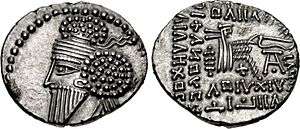Osroes I

Osroes I (Greek version of Khusraw) or Chosroes[1] Parthian: 𐭇𐭅𐭎𐭓𐭅 (Husrōw)was a prince of Iranian and Greek ancestry. He ruled the Parthian Empire from 109 to 129, with a brief interruption from 116 to 117. He succeeded his brother Pacorus II. For the whole of his reign he contended with the rival King Vologases III based in the East of Parthia.
Biography
Osroes I was one of the sons born to Vonones II by a Greek concubine. He invaded Armenia and placed first his nephew Axidares and then his brother Parthamasiris on the Armenian throne. This encroachment on the traditional sphere of influence of the Roman Empire — the two great empires had shared hegemony over Armenia since the time of Nero some 50 years earlier — led to a war with the emperor Trajan.
In 113 Trajan invaded Parthia, marching first on Armenia. In 114 Parthamasiris surrendered and was killed. Trajan annexed Armenia to the Roman Empire. Then he turned south into Parthia itself, taking the cities of Babylon, Seleucia and finally the capital of Ctesiphon in 116. He deposed Osroes I and put his own puppet ruler, Osroes' son, Parthamaspates, on the throne. In Mesopotamia Osroes I's brother Mithridates IV and his son Sanatruces II took the diadem and fought against the Romans, but Trajan marched southward to the Persian Gulf, defeated them, and declared Mesopotamia a new province of the empire. Later in 116, he crossed the Khuzestan Mountains into Persia and captured the great city of Susa.
Following the death of Trajan and Roman withdrawal from the area, Osroes I easily defeated Parthamaspates and reclaimed the Persian throne. Hadrian acknowledged this fait accompli, recognized Osroes I, made Parthamaspates King of Osroene, and returned Osroes I's daughter, who had been taken prisoner by Trajan.
It seems that the conflict with Rome had weakened Osroes I and strengthened his rival Vologases III—from about 121 there are few coins of the former and many of the latter. Osroes I was succeeded by his brother Mithridates IV, who continued the struggle against Vologases III.
Citations
- ↑ Drijvers & Healey 1999, p. 36.
References
- Toumanoff, Cyril (1986). "Arsacids". Encyclopaedia Iranica, Vol. II, Fasc. 5. Cyril Toumanoff. pp. 525–546.
- Drijvers, Han J. W.; Healey, John F. (1999). "History, culture, and religion of Edessa". The old Syriac inscriptions of Edessa & Osrhoene: Texts, translations, and commentary. Brill. ISBN 978-90-04-11284-1. ISSN 0169-9423.

- Pausanias, v, 12.
- Cassius Dio, lxviii, 17–33.
- Aelius Spartianus, Vita Hadrian, v, 13.
- John Malalas, Chronographia.
Osroes I | ||
| Preceded by Pacorus II |
Great King (Shah) of Parthia 109–116 |
Succeeded by Parthamaspates |
| Preceded by Parthamaspates |
Great King (Shah) of Parthia 117–129 |
Succeeded by Mithridates IV |